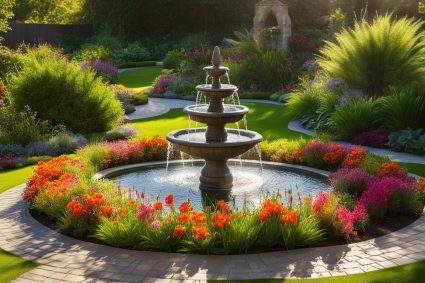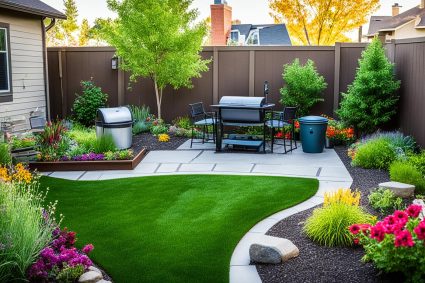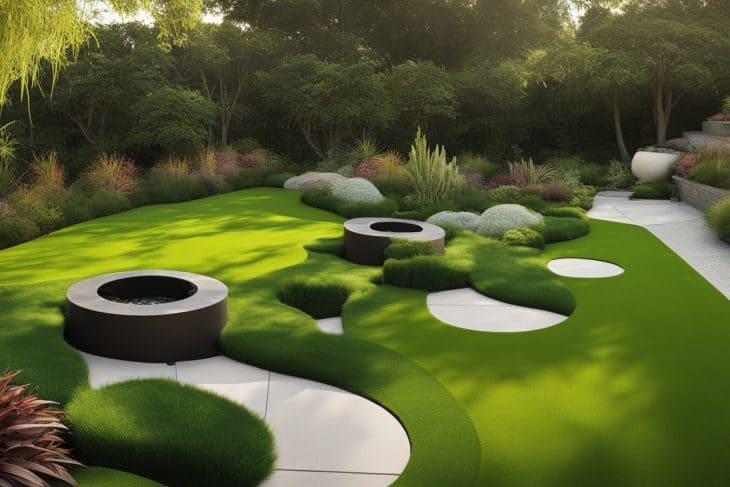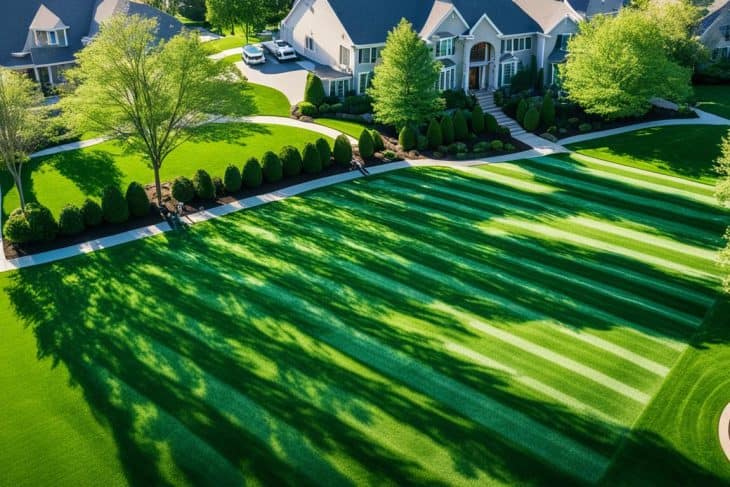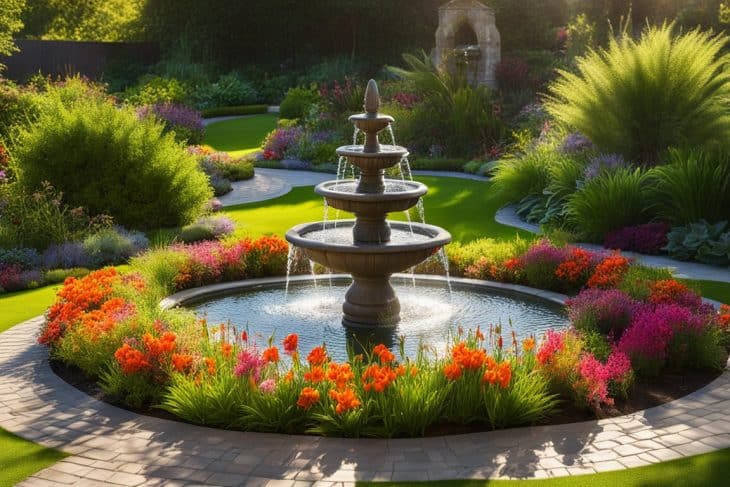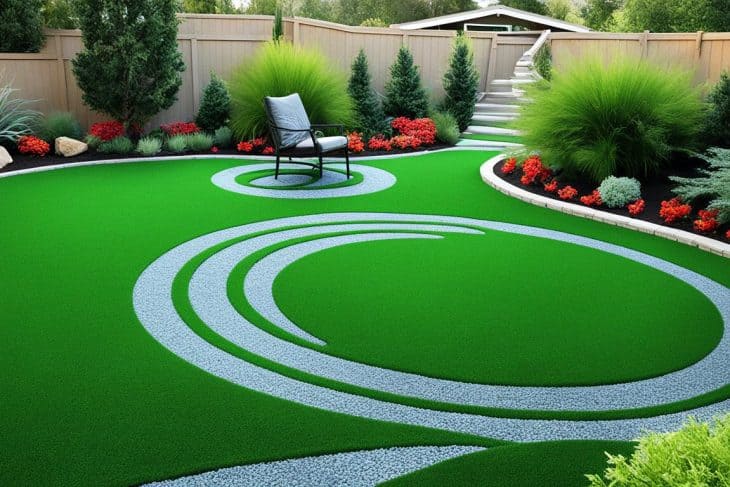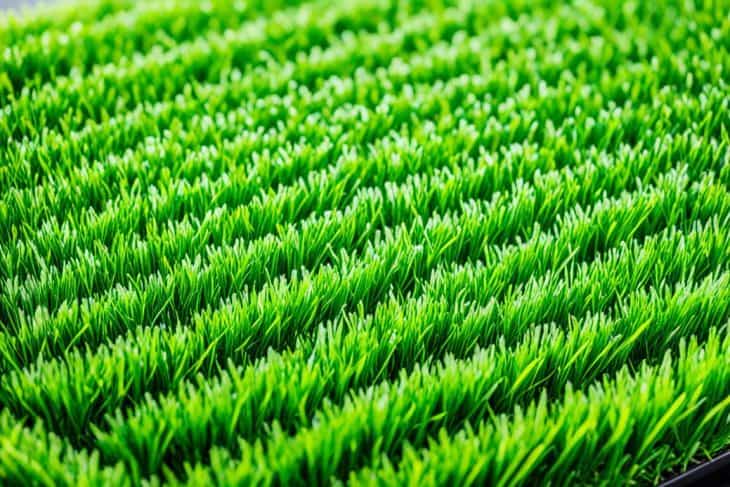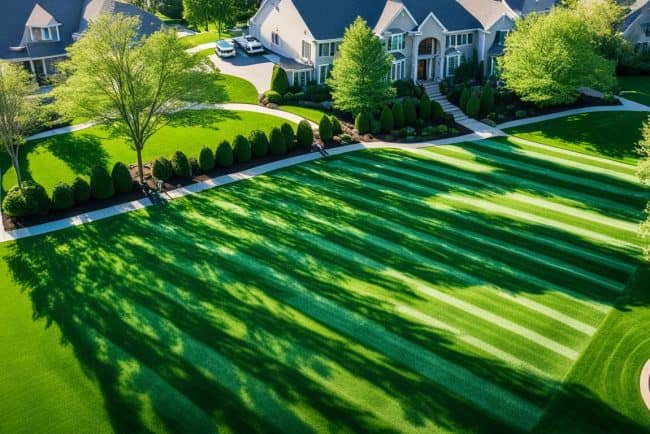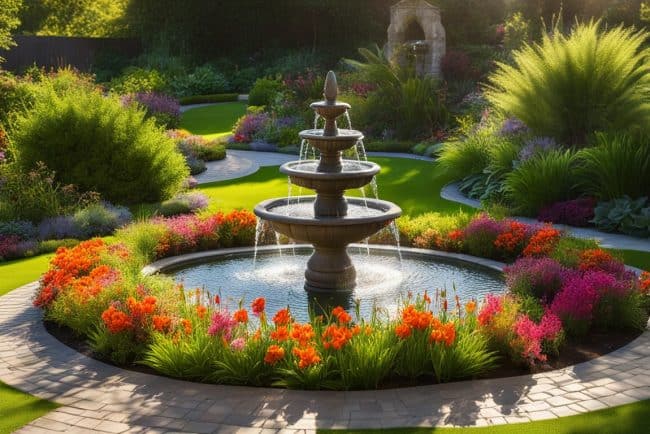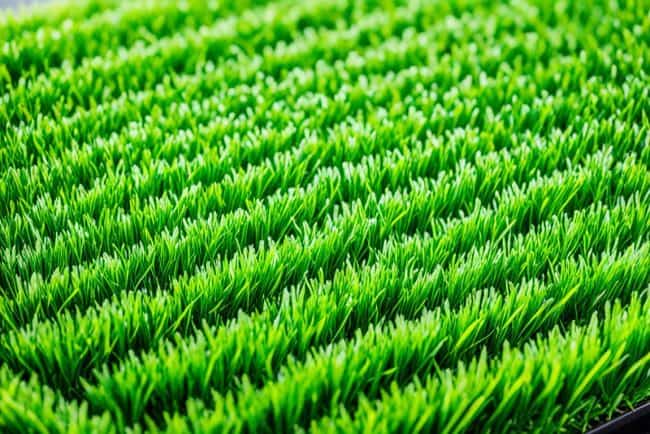
Did you know that a third of all water used at homes in the U.S. goes to traditional lawns? With climate change and the lack of water becoming big issues, more folks are choosing eco-friendly artificial grass. This turf cuts down on water use, saves on upkeep, and helps the planet. As more people understand the impact of regular lawns, they’re picking synthetic grass. This grass is safe for the environment and made with things like soybean oil. In this piece, I’ll look at the good points, how to install, and keep up eco-friendly artificial grass. It shows how outdoor areas can turn more green.
Key Takeaways
- Eco-friendly artificial grass significantly reduces water consumption compared to traditional lawns.
- The switch to synthetic turf helps in lowering carbon emissions by eliminating the need for gas-powered lawnmowers.
- By providing a pesticide-free environment, artificial grass promotes a healthier ecosystem.
- Long-term financial savings come from reduced water bills and minimal maintenance costs associated with synthetic grass.
- Modern synthetic turf mimics and often surpasses the appearance of natural grass, ensuring a vibrant look.
- Adopting artificial grass as part of green landscaping contributes to more sustainable and environmentally responsible practices.
Understanding Eco-Friendly Artificial Grass
Eco-friendly artificial grass offers a sustainable choice compared to normal lawns. It looks like natural grass but needs less water and upkeep. This green product is great for the environment and for homeowners.
Definition and Composition
Eco-friendly artificial grass is synthetic turf that looks like real grass. It’s a good choice for green yards. It’s made of materials like polyethylene and some plant fibers. Resources like soybean oil back it up. This makes sure it meets high environmental standards. It uses eco-friendly parts and cuts down on bad chemicals.
Key Environmental Benefits
The benefits of this artificial grass are big. Homeowners can save about 22,000 gallons of water each year. This means lower water bills and it’s better for the planet. Plus, it lasts for up to 25 years. So, there’s less waste from replacing it.
Using synthetic grass stops the need for harmful chemicals. This makes our earth healthier. It’s also tough, which means less upkeep and fewer gas emissions from lawn tools. By choosing eco-friendly grass, you support saving water. It also keeps landscapes stable by stopping erosion and too much watering.

Green Landscaping Practices Incorporating Artificial Grass
Using artificial grass in our gardens helps save water, especially where it’s scarce. For homeowners, it means less water use and saving money.
Water Conservation and Cost Savings
Artificial grass is great for saving water. In dry areas, it means less need for watering the garden. Homeowners could use up to 22,000 gallons of water less every year. Plus, no need for watering, cutting, or adding stuff to keep it green. So, homeowners save money and help the environment at the same time.
Reduced Carbon Emissions
Artificial grass helps cut down on carbon emissions, too. Mowing and trimming with gas equipment creates pollution. By choosing fake grass, I’m doing less of these tasks and making the air cleaner. It’s a smart move for cities trying to be greener and saves water too. Picking artificial grass increases home value and supports the environment.

Environmental Benefits and Advantages of Eco-Friendly Artificial Grass
Choosing eco-friendly artificial grass has many environmental perks besides looking good. It offers health and safety pluses and helps the ecosystem.
Health and Safety Benefits
One top health benefit of artificial grass is fewer allergens. Things like pollen and mold aren’t a problem. It also gets rid of the need for harmful pesticides, making it better for families and pets.
Kids can play outside without touching toxic chemicals. This makes outdoor activities safer.
Longevity of Eco-Friendly Turf
The longevity of artificial turf is impressive. Good quality materials last 10 to 20 years, based on how they’re used.
Many eco-friendly types use recycled stuff and meet USDA sustainability standards. Homeowners save money over time because these lawns need less care than normal grass. They are very durable.
Reduction of Allergens and Toxic Chemicals
Artificial grass helps lower allergens and toxic chemicals in the air. With no pesticides, it keeps local water clean and improves air quality around houses.
Choosing eco-friendly options means a healthier place for families. And it supports green practices that help everyone.
| Feature | Eco-Friendly Artificial Grass | Natural Grass |
|---|---|---|
| Life Span | 10-20 years | 1-3 years (high maintenance) |
| Maintenance | Low (no mowing, watering, or pesticides) | High (frequent mowing, watering, chemical applications) |
| Allergen Reduction | Significant | High (pollen and spores) |
| Water Usage | Minimal | High (daily watering needed) |
| Environmental Impact | Lower carbon emissions | Higher due to lawn care equipment |
Installation of Eco-Friendly Artificial Grass
Installing eco-friendly artificial grass makes your landscape both sustainable and good-looking. By following eco-friendly turf installation steps, you get a long-lasting lawn. This way, you also reduce harm to the environment. Here are the right steps to take.
Step 1: Clear the Area
Start by removing any old grass, roots, and trash from the area. This makes the ground flat for the artificial grass. A flat surface helps build a strong foundation for your new lawn.
Step 2: Add a Base Layer
Then, put down a compact layer of crushed stone or gravel. This layer aids in drainage and keeps the turf stable. A well-prepared base means your artificial grass will stay perfect in all seasons.
Step 3: Lay the Turf
After preparing the base, it’s time to lay down the turf. Unroll the artificial grass carefully, making sure the edges match. This is important for your yard to look natural and seamless.
Step 4: Secure the Turf
Next, fasten the grass to the ground with landscape staples or glue. This action ensures the turf stays in place. It will be able to handle weather changes and people walking on it.
Step 5: Add Infill
Finally, spread the right infill material on the turf to improve its structure. This step gives support and keeps the grass looking fresh. Choosing a suitable infill is crucial for the best results from your eco-friendly artificial grass.

Maintenance Tips for Eco-Friendly Artificial Grass
Caring for artificial grass properly keeps it fresh and green. It’s simple to maintain yet ensures it lasts long. I’ve found certain tips really helpful to keep my eco-friendly grass in top shape.
Regular Brushing
To keep artificial grass looking good, regular brushing is key. Use a plastic or bamboo rake for this. It helps grass blades stand tall and avoids them lying flat. This not only makes the lawn look better but also prevents the blades from matting together. Brushing in the opposite direction of the blades keeps the lawn soft and extends its life. These steps help keep my lawn beautiful with little effort.
Cleaning Up Spills
Spills will happen, but quick cleaning avoids permanent marks or smells. A mild soap and warm water mix works best for me. This way, I steer clear of strong chemicals that can harm the grass. Rinsing the grass now and then also removes dust and keeps the yard clean. These simple practices keep my artificial grass looking great.
It takes some care to keep artificial grass looking great. But with the right care, eco-friendly grass is easy to maintain. This makes for a lovely, green space outdoors that lasts long.
Cost-Effectiveness of Eco-Friendly Turf
Investing in eco-friendly artificial grass is smart financially and for the environment. While it might cost more upfront, the long-term savings are clear. Homeowners benefit from lower water bills, which is important in states like Arizona where water prices are going up.
Long-Term Savings on Water Bills
Artificial turf can save about 660,000 gallons of water over 15 years. This can mean saving thousands on water bills. It also needs much less water than regular grass, cutting water use by up to 70%.
Decreased Maintenance Costs
Artificial grass also saves money on upkeep. Natural grass lawns cost a lot each year for water, fertilizers, pesticides, and mowing. Eco-friendly turf avoids these costs and doesn’t need nasty chemicals. This not only saves money but helps the planet. Artificial grass lasts longer too, so you won’t need to replace it as often.
Customizable Options for Artificial Grass
Customizing artificial grass for eco-friendly landscaping is a great choice. Homeowners can pick from many design options. This means getting the perfect look and feel for your yard is easy.
Whether you want a yard that looks naturally lush or modern and bright, there’s a match. You can find the right texture, color, and length to meet your vision.
Artificial grass is versatile and fits many places. People use it in homes, businesses, and parks all over the U.S. With pro installation, artificial grass drains well and lasts long in busy spots.
It’s tough enough for kids and pets to play on without getting ruined. This makes it a solid choice for any outdoor space.
Eco-friendly artificial grass can last over 15 years. Choosing it means your yard matches your style and supports the environment. It makes your space welcoming and cuts down on lawn care costs and water use.
